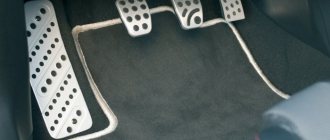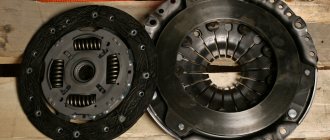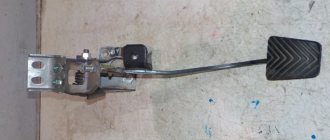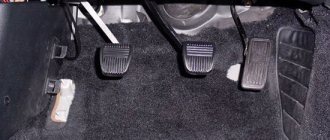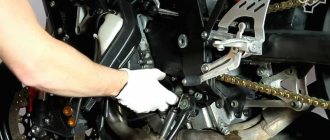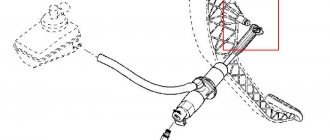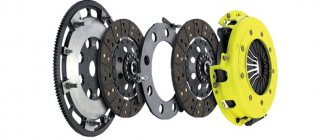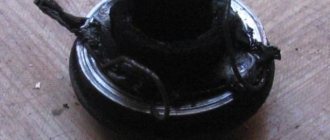The design of a car with a manual transmission necessarily requires the presence of a clutch mechanism in the transmission device. At the same time, it should be noted the importance of this unit, since it is thanks to the clutch that torque is transmitted from the engine to the wheels, and it is also possible to move away softly and smoothly and then change gearbox gears.
Simply put, the clutch connects the gearbox and the engine, allowing the force of the internal combustion engine to be transmitted to the transmission. Moreover, if such a need arises, the clutch allows you to “unloose” the rigid connection between the internal combustion engine and the gearbox. In this article we will take a detailed look at what a clutch is for and how a car’s clutch works, as well as what to pay attention to when operating a car with a manual transmission.
Car clutch device
The operation of the car’s clutch is ensured by the following parts:
- flywheel;
- fork;
- pressure disk;
- spring (can be push or pull type);
- release bearing and clutch;
- driven disk;
- drive elements.
The flywheel is responsible for transmitting torque to the gearbox. It is mounted on the crankshaft of the engine. The pressure plate, or as it is also called the “basket,” is an element rigidly fixed on the flywheel, to which the springs of the driven disk are attached.
The pressure and driven disks in connection with the flywheel are responsible for the smooth distribution of torque from the engine to the manual transmission. The parts are in close contact with each other or move away from each other, depending on the pedal press inside the car.
The push clutch performs the main function: it smoothly disconnects during braking and connects the engine and gearbox when starting. At the same time, it compensates for the load and minimizes the vibration impact from the engine, thereby partially unloading the elements of the engine, vehicle transmission and clutch unit.
The release bearing protects the clutch from wear. When you press the pedal, the fork separates the pressure and driven discs. The remaining components of the clutch drive are cables, hydraulic cylinders, tubes and the pedal itself.
Clutch: why is it needed and how does it work?
Understanding the purpose of the clutch pedal, you first need to understand the operating principle of this important unit. Since the unit is considered one of the fundamental elements of the car’s chassis, it makes it possible to disconnect the crankshaft from the gearbox. It is the ability to perform this action in a short period of time that allows motorists to change gears while driving. Most modern car models have a single-plate friction clutch. That is, such a clutch device requires the presence of a main element and a drive. The clutch assembly, for a clearer understanding, consists of the following elements:
What happens when you press the pedal
It is physically impossible to change speed with constant engine pressure on the gearbox. The clutch was invented in order to smooth out vibrations. It absorbs impacts during the transition from gear to gear, protecting the car from overloads.
The switching process is as follows:
- the driver from inside the car presses the clutch pedal with his left foot;
- the fork moves the release bearing;
- the release bearing secures the blades of the diaphragm spring;
- the compressed spring stops pressing on the pressure plate;
- the engine is disconnected from the transmission;
- the driver releases the clutch pedal;
- the fork does not affect the release bearing and spring;
- the pressure plate presses the driven disk against the flywheel;
- The transmission is reconnected to the engine.
Types
The clutch varies:
by type of drive (models with hydraulic, mechanical or electrical control);
- by type of friction (the mechanism can operate in an oil bath or without it);
- by the number of driven disks;
- by type of spring arrangement;
- by switching mode.
The most common today are models with one or more friction discs, that is, those that operate due to friction (without additional lubrication). Depending on the number of driven elements, they can be single-disk, double-disk or multi-disk (three or more).
How to understand that the clutch is breaking
There are “bad habits” that lead to rapid wear of the car’s mechanical clutch. You should try to avoid them in order to prolong the life of the parts. Will lead to a quick repair:
- Intensive pressing of the gas pedal when starting the car. The higher the engine speed when the clutch is depressed, the more the discs wear out.
- Keeping the clutch pedal depressed during short stops, for example, at a traffic light. Excessive pressure exhausts the life of the release bearing and pressure spring. In such situations, it is better to switch to neutral gear.
- The habit of forgetting to release the pedal and driving like this for some distance. Novice drivers can get confused with their feet and pedals when driving with the clutch depressed. Instructor tips and driving practice will help you avoid this mistake.
- Keeping your foot not on the side, but on the clutch pedal, while the car is moving. Even if you seem to be in control and are not pressing the pedal, the driven disc will not be pressed tightly enough against the flywheel. This will lead to its premature erasure.
To avoid having to constantly change parts, you need to immediately learn how to change gears correctly and smoothly press and release the pedals. But after some time, a loaded system will still wear out. If the gears begin to change poorly or the car starts to move only when the clutch pedal is completely released, this is a reason to sign up for an auto repair shop.
In addition, the following may indicate a breakdown:
- strong vibration when pressing the pedal;
- grinding, crackling noise when changing gears;
- jerks when starting from a standstill even with the clutch released smoothly;
- uncharacteristic whistle, hum, squeal when squeezing the pedal;
- slipping, accompanied by a burning smell;
- difficult pressing or jamming - the lever is squeezed all the way, but does not return to its original position.
Common Clutch Problems
In the 1950s - 1970s. I had to change the clutch every 80,000 - 100,000 km. The service life of modern clutches is more than 130,000 km with proper operation and maintenance. Otherwise, the clutch may fail at 55,000 km. Overloaded trucks and tractor-trailers that tow heavy loads can have problems even with a new clutch. The main problem is wear of the friction material of the disc. The friction material on the clutch disc is similar to the friction material on brake pads - it wears away over time. When most of the friction material wears out, the disc begins to slip and the clutch does not transmit power from the engine to the wheels. Clutch wear only occurs when the discs rotate at different speeds. When the discs are pressed together, the friction material holds the discs together and they rotate at the same speed. Wear occurs when the clutch disc slips over the pressure plate. But if you drive with frequent clutch slippage, wear goes much faster. Clutch problems can also occur if the clutch disc cannot come off the pressure plate. If the clutch is not fully depressed, it continues to rotate the drive shaft. This may result in the gear shifting "squeaky" or the gears jamming. This may happen for the following reasons:
Tips for beginners
To avoid burning out the clutch when starting and changing gears, use the basic recommendations from the Akademika driving school.
Algorithm for moving away with a manual transmission:
- start the engine;
- press the brake and clutch pedals all the way;
- move the handbrake to the down position;
- put the lever in first gear;
- smoothly release the clutch pedal while keeping your right foot on the brake;
- press on the gas little by little, releasing the brake.
To change gear correctly, first depress the clutch all the way. Shift to the desired speed by moving the lever and slowly release the pedal until the engine changes RPM. Add some gas and release the clutch completely.
The main thing is, don’t be afraid, do everything smoothly and consistently. If that doesn't work and the car stalls, turn on the hazard lights. Calm down and start over. It is important to learn how to start and change gears correctly, so that you can reinforce this habit later. Only daily practice and self-confidence will help with this!
Why is a clutch necessary to start a car moving?
Let's start with the fact that the clutch can be depressed sharply, but the pedal must be released smoothly. At the same time, at the very beginning of the movement, in order for the car to move off as smoothly as possible, it is necessary to gently release the clutch pedal.
Otherwise, the smoother the driver releases the pedal, the “softer” the discs close, the thrust from the engine is not transmitted abruptly, but gradually, no shock loads are created, etc. Later, when the car starts moving, the clutch can be released faster, but you shouldn’t release the pedal too sharply either.
We also recommend reading the article on how to drive a manual transmission correctly. From this article you will learn how to change manual transmission gears, what to pay attention to when starting, etc.
In cases where the driver releases the pedal too sharply when starting off, the car jerks forward and the engine usually stalls. If at this moment you press the gas hard instead of the brake, there is a risk that the engine will not stall and the car may rush forward, which often becomes the cause of an accident.
As a rule, novice drivers, as well as those who have previously driven only automatic transmissions, take some time to learn how to release the clutch correctly. It is important to control the pedal, depress the clutch all the way before engaging the gear, and also feel the moment the clutch discs begin to close and the moment when the discs are completely closed. This allows you to start correctly from a standstill, control the traction with the gas pedal, and not wear out the engine, clutch and gearbox.
Brief historical background
While working on the creation of the first cars, engineers discovered the need for a device that would transmit torque from the engine to the wheels, but with different amplitudes of rotation, so that the car would move smoothly. Without such a device, every time you wanted to slow down or increase the speed, you would have to completely turn off the engine. And this device was invented by the German engineer Karl Benz in 1885. The clutch then consisted of two pulleys connected by a leather belt. The driver moved the pulleys apart with a lever, which made it possible to open and close the clutch.
The next stage in improving the device was the invention of the cone clutch by German engineers Gottlieb Daimler and Wilhelm Maybach in 1889. In the cone clutch design, the leather belt is replaced by a spring. This design was replaced by another - a multi-disc one, which worked in a liquid medium (kerosene or oil). Then Ferodo linings began to be put on the discs, and the automotive industry switched to dry single-plate clutches. The prototype of the modern diaphragm clutch was developed by auto mechanics of the American corporation General Motors in 1936, but due to the war, their mass production began only in 1965 and continues today.
Some tips on when to use the clutch
Quite often you can hear that the lightest pedal is the clutch, because it is not directly responsible for either braking or acceleration. It is worth noting that such a statement is erroneous.
It is the clutch that allows experienced drivers to control the vehicle as efficiently as possible.
With its help, you can achieve maximum performance and durability of the vehicle. On the other hand, improper use of an element often leads to premature wear of several machine components (including the engine). Thus, there is a need to learn how to use the clutch at the right moment. Now we will talk about how and when to use the clutch. But first you need to make sure that the clutch has been adjusted correctly.
How the clutch works
In its most general form, its design is shown in the figure below.
Without going into details, it should be noted the presence of such components as the flywheel (1), which is also part of the engine, as well as the driven disk (2), clutch basket (3) and, of course, the drive, which includes almost all other parts, including including the clutch pedal (11). Here it is only necessary to say that a rather enlarged and simplified presentation of the design is given, which in no way, however, interferes with the understanding of its meaning, the role of this mechanism on the machine. To properly understand the design, it is necessary to clarify that the drive connecting the clutch pedal with the mechanism itself can be:
- hydraulic, as shown in the figure above;
- mechanical;
- pneumatic;
- electric, etc.
What is a car clutch
Structurally, the clutch (friction clutch) in a car is designed to connect and disconnect the engine shaft with an automatic or manual transmission.
This allows you to move away without sudden jerks and ensures smooth gear shifting on the move, preventing overload of the transmission components due to changes in the crankshaft speed.
There are different drive designs for transmitting force from the pedal to the pressing mechanisms, such as mechanical, hydraulic and electric.
Disengage - clutch
The clutch is released using a foot pedal, hinged on a bracket on the left side member of the frame. The lower end of the pedal is connected by an adjustable rod to the shift fork lever. When the bearing fork is moved to the left, the levers, which are connected with the fingers to the pressure plate and fork, press the pressure plate. The forks can make slight oscillatory movements when the clutch is engaged and disengaged due to the fact that special nuts screwed onto the threaded ends of the forks serve as support points for the levers on the casing. The nuts are pressed against the clutch housing by support plates. The plates are secured to the casing with bolts. Due to the elasticity of the plates, engagement and disengagement of the clutch is ensured smoothly. [1]
The clutch is released by pressing the clutch pedal. The latter, turning around their axes, move the pressure disk 2 away from the flywheel /, releasing the driven disk 3 and disengaging the clutch. The clutch is engaged by springs when the pedal is released. [3]
To disengage the clutch, press the clutch pedal. [5]
To disengage the clutch, a sliding clutch with bearing 6 is used, the force to which is transmitted from the control pedal through a hydraulic drive. [7]
To release the clutch, levers 4 are used, connected to the pressure plate and forks using fingers mounted on needle bearings. Spherical nuts threaded onto the threaded ends of the forks serve as fulcrum points for the levers on the clutch housing. These nuts are held in place by elastic plates that are bolted to the clutch housing. [8]
To release the clutch, levers 9 are used, which are connected to the pressure plate and to forks 8 with pins 6 mounted on needle bearings. Spherical nuts screwed onto the threaded ends of the forks serve as support points for the levers 9 on the clutch housing. These nuts are held by elastic plates 7, which are attached to the clutch housing with bolts. On the outside, the clutch is covered by a 4-flywheel housing. [9]
A mechanical or hydraulic drive can be used to disengage the clutch. [10]
To disengage the clutch, a sliding clutch with bearing 6 is used, the force to which is transmitted from the control pedal through a hydraulic or cable drive. [eleven]
After disengaging the tractor clutch, brakes are used to quickly stop the driven parts of the latter. [12]
The clutch release drive on a MAZ-500 car (Fig. 78) includes: pedal 24, a system of rods and levers, a clutch release clutch with a thrust ball bearing, a thrust ring and a pneumatic amplifier. The opposite short ends of the release levers move back, pull the pressure plate back (to the right), the driven disk is released, and the clutch is disengaged. Between the thrust ball bearing and the thrust ring when the clutch is engaged there should be a gap of 3 2 - 4 mm, which corresponds to a free play of the clutch pedal of 45 - 55 mm. The free play of the pedal is adjusted by changing the length of the clutch release rod. [14]
Clutch release pedal/hinged type, mounted on a bracket under the instrument panel, to the left of the steering column. [15]
What to remember when starting out
When the vehicle is started, the gear lever must be in neutral. To prevent damage to the clutch, the pedal must be depressed and then set to first gear. It is important that the crankshaft and gearbox connect as smoothly as possible, without jerking.
To competently move from neutral to first speed, you must follow the following points:
- squeeze the medal a little. If the flywheel connects smoothly to the disk, the machine will begin to move at minimum speed;
- pause for a few seconds. As a result, a balance will be established between the rotation of the flywheel and the disk. This will result in a slight increase in speed;
- then release the pedal. Do not overexert the clutch, otherwise the disc will wear out prematurely.
Automatic car
In the automatic version, the clutch occurs according to the “wet” type using transmission oil enclosed in a torque converter and two impellers. The flywheel blades carry with them a flow of oil, which spins the pump wheel - this is how rotation is transmitted in an automatic transmission (automatic transmission)
Such an automatic car does not have a clutch pedal, so in general the driving process itself will be simpler and easier (there are especially many fans of automatic transmission among women).
